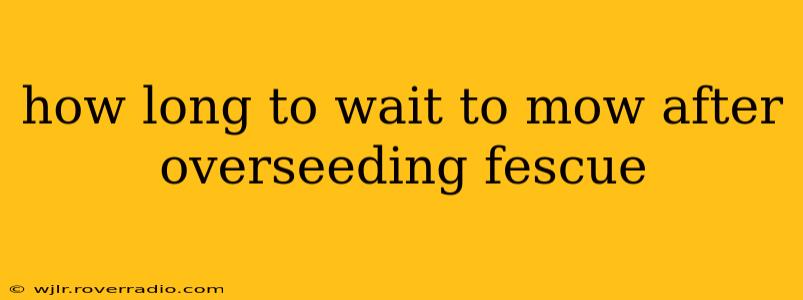Overseeding your fescue lawn is a great way to thicken it up, fill in bare patches, and improve its overall health. But knowing when to fire up the mower after spreading those precious seeds is crucial for successful germination and establishment. Waiting too long can lead to uneven growth, while mowing too soon can severely damage your new seedlings. Let's break down the ideal timeframe and other important considerations.
How Long Should I Wait Before Mowing After Overseeding Fescue?
The general rule of thumb is to wait at least 30-45 days after overseeding before your first mow. This allows the seedlings sufficient time to establish a strong root system and grow to a height where they can withstand the stress of mowing. However, this isn't a hard and fast rule; several factors can influence the optimal mowing time.
Factors Affecting Mowing Time After Overseeding:
- Seed Type: Different fescue seed types germinate at varying speeds. Some varieties might be ready for a light mow slightly earlier than others. Check the seed packaging for specific germination information.
- Soil Conditions: Well-draining soil promotes faster germination. Moist, fertile soil generally leads to quicker establishment, while dry, compacted soil may slow things down.
- Weather Conditions: Warm temperatures and adequate moisture accelerate germination and growth. Conversely, cold temperatures and drought conditions will slow down the process, necessitating a longer wait before mowing.
- Seed Germination Rate: Even under ideal conditions, the germination rate can vary. Monitor your lawn closely—if seedlings are consistently growing well above the recommended height, you can consider a very light mow sooner.
What Happens If I Mow Too Soon After Overseeding?
Mowing too early can be disastrous for your overseeding efforts. Here's what can happen:
- Seedling Damage: The mower blades will scalp newly emerged seedlings, potentially killing them outright or severely hindering their growth. This results in thin patches and an uneven lawn.
- Stunted Growth: Even if the seedlings survive, the stress of early mowing can stunt their development, delaying the establishment of a healthy, dense lawn.
- Uneven Lawn: Areas where seedlings are more established might survive, while other areas will be severely damaged, leading to an inconsistent lawn appearance.
What Happens If I Wait Too Long to Mow After Overseeding?
While mowing too soon is detrimental, delaying your first mow for too long also has its drawbacks:
- Competition from Existing Grass: If you wait too long, the existing fescue may outcompete the seedlings for resources, leading to stunted growth of the new seed.
- Thatching: Excessive thatch can prevent the seedlings from establishing a strong root system. A light mow can help thin out the thatch and create better conditions for the new grass.
How High Should I Mow After Overseeding?
Your first mow after overseeding should be a very light cut. Set your mower blades to a higher setting than you typically use. Aim to remove only the top third of the grass blades, leaving plenty of leaf area to aid in photosynthesis. This helps maintain a healthy lawn and ensures your seedlings have ample space and energy to flourish.
When Should I Start Fertilizing After Overseeding?
Generally, you should wait until after your first mow before fertilizing. This gives the seedlings a chance to establish their root systems and prevents burning the tender new growth with the fertilizer.
Should I Water After Overseeding and Mowing?
Consistent watering is critical for successful overseeding. Continue watering regularly even after the first mow, ensuring the soil remains consistently moist but not waterlogged. This is crucial for the ongoing growth of the new seedlings.
By following these guidelines and paying close attention to your lawn's progress, you can ensure your overseeding efforts result in a lush, healthy, and beautiful fescue lawn. Remember patience is key; take your time, and you'll be rewarded with a thriving lawn!
